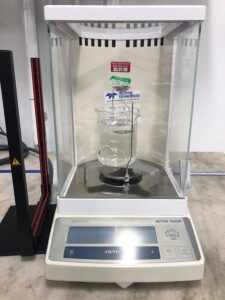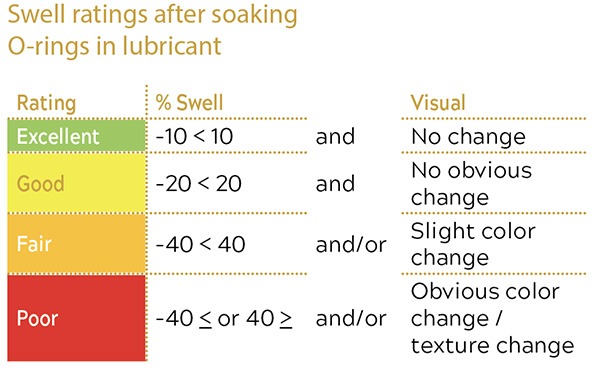Evaluate Before Lubricating Polymers

While lubricants are typically used to minimize wear between metal parts, they also need to lubricate polymer or elastomer parts without damaging them. Understanding how materials interact with each other and identifying compatible combinations can be a challenging task.
This balance, fitted with a density-determination kit, is part of a simple test to determine lubricant compatibility with elastomer O-rings.
Elastomers are complex materials that consist of a base polymer or copolymer and fillers. The composition and properties of polymers can be influenced by factors such as molecular weight, chain structure, degree of cross-linking, and the type and concentration of fillers used. In contrast, lubricants are made up of a base oil, thickener, and additives. The additives in various lubricants can consist of thousands of options. Although present only in small quantities, they can significantly affect material compatibility.
Incompatibility between polymers and lubricants can cause physical changes that have an impact on functional properties. This can include changes in size, durometer, brittleness, and color. These changes can compromise a material’s performance and, in some cases, render it unsuitable for the specific application. Interaction between the lubricant and the polymer can also have an adverse effect on the lubricant’s properties, changing its viscosity and rheological properties. It’s therefore important to conduct tests to evaluate compatibility.
Compatibility charts serve as a starting point when evaluating interactions between different materials. However, they cannot guarantee compatibility of any given combination of materials. To understand how different materials interact, it is necessary to test specific formulations in standardized ways. There is no one test to evaluate the compatibility of materials and the tests conducted depend on the properties evaluated.
Several different ASTM standards exist to evaluate material compatibility, including ASTM D471, ASTM D543, ASTM D7264, ASTM D790, ISO 175, ISO 178, ASTM D638, and ISO 527. These standards evaluate tensile strength, thermal expansion, and flexural properties, as well as the impact of liquid chemicals on polymer materials.
A simplified test can be conducted to evaluate compatibility where a lubricant is evaluated against an elastomer O-ring. This method involves soaking O-rings of various materials, such as buna-nitrile, EPDM, silicone, and PTFE, in the lubricant of choice in an oven set at 125 C for three days. The dry and wet mass of each O-ring before and after exposure is measured using an analytical balance fitted with a density determination kit. The method calculates the volume swell (ΔV%) by using the initial mass and the mass after exposure. A visual inspection is also performed to assess compatibility. This test method determines compatibility between a lubricant and elastomer under exposure conditions. The swell between O-rings may or may not be easily seen while, in some cases, it can be significant.
While testing is an important step in understanding material compatibility, it’s not the only consideration. Compatibility is also dependent on the specific application of the materials. Swelling can be beneficial for some applications, such as sealing an interface. In others, it can cause components not to fit together as intended. It is important to understand how any observation will affect the specific application.
Investigating the compatibility between lubricants and polymers/elastomers is essential for understanding their interactions with one another. Standardized methods exist to evaluate the properties of these materials under different conditions. Several standard methods for elastomer compatibility are available and can be supplemented and used in conjunction with each other as needed. Observations should be contextualized to the specific application to ensure that changes do not compromise the functionality of the materials. EP
By William Fick, DuPont
William M. Fick is a Lubricant Application Engineer for MOLYKOTE Specialty Lubricants, a division of DuPont, Wilmington, DE (dupont.com). He provides engineering and design support with an emphasis on industrial applications. Fick earned a B.S. in Mechanical Engineering.
The post "Evaluate Before Lubricating Polymers" appeared first on Efficient Plant



